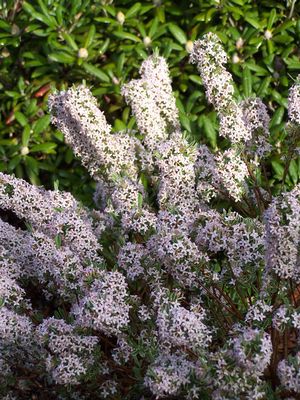View All Plants :: View All DECIDUOUS SHRUBS
Daphne x burkwoodii 'Carol Mackie'
Daphne
Plant Type:
DECIDUOUS SHRUBSDaphne x burkwoodii ‘Carol Mackie’ – This Daphne is very well-known, likey the most recognized of the entire genus. ‘Carol Mackie’ is a branch sport found in a garden in New Jersery in the 1960s is probably the best known of the Daphnes. Vigorous, with cream-edged green leaves, the margins maturing white, and a heady perfume from pastel pink flowers in May/June. The Burkwood Hybrids all come from the crossing of D. cneorum with D. caucasica. 'Carol Mackie' and the following Burkwood Hybrids are good choices for those who have yet to try their gardening hands with Daphnes as these plants exhibit “hybrid vigor”. Rounded habit.
For a fun read please see Daphne
Characteristics and Attributes for Daphne x burkwoodii 'Carol Mackie'
Season of Interest (Flowering)
- Spring
Season of Interest (Foliage)
- Spring / Summer / into Autumn
Nature Attraction
- Deer Resistant
Light
- Full Sun
- Morning Sun / Afternoon Shade
Attributes
- Border
- Drought Tolerant
- Foundation
- Fragrant
- Shrub Border
- Specimen
Growth Rate in the Garden
- Moderately Fast
Soil
- Scrabbled
- Draining
- Average
Origins
- Garden Origin
Propagated By
- Cutting Grown
Genus Overview: Daphne
Daphnes are shrubby members of Thymelaeaceae. Many have thrived in our xeric garden which provides a deep root run, good drainage with no extra water during droughts. We add dolomitic limestone to the planting holes when initially interring them. Most have fragrance which is heavenly, perfuming the air near where they bloom. We have observed those that flower or rebloom in summer draw hummingbirds.
For all the discussion about their finicky personalities we have found them mostly quite easy to please in the ground though they, as a group, are largely not happy in containers for long; in containers death visits frequently - especially the yearlings - and it is as annoying as frustrating! As my good friend, Jonathan Lehrer, has told me on occasion, “Daphnes will never be a mainstream shrub because even the easy ones will up and die suddenly for no apparent reason.” My feeling is nothing goes on living forever; for all of their remarkable qualities they are worth growing for as long as they choose to be around! Certainly, the hybrids (x burkwoodii and x transatlantica) exhibit exceptional hybrid vigor, strength and ease of establishment.
Snow loads in the north can be an issue on taller growers, therefore, I suggest pruning older plants after flowering to ensure stouter, bushier shrubs that may better counteract weighty winter precipitation. After pruning they recover beautifully and quickly. Also, all that flower in summer are attractive to hummingbirds. Most of our selections come to us gratis from John Bieber who lives on Long Island, longtime lover of all things Daphne. Most of our Daphnes are cutting grown. There are exceptions including D. alpina which has been completely resistant from stem cuttings; these will be seed grown when we do have them available which may be infrequently!


